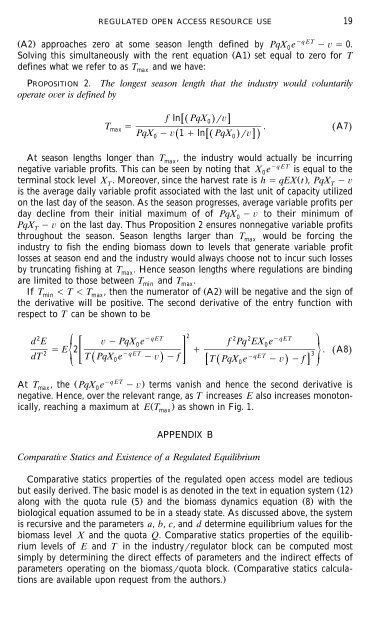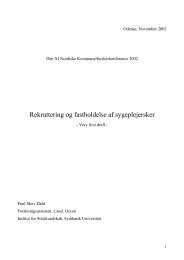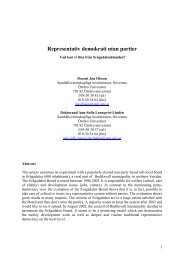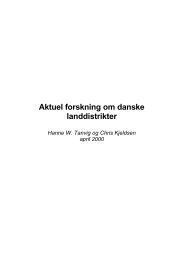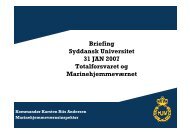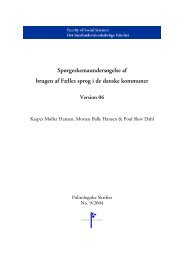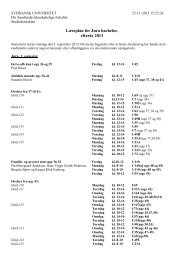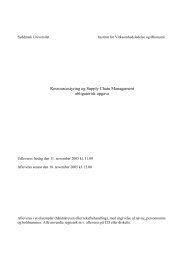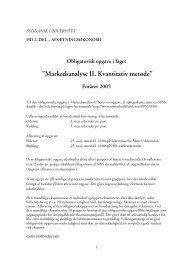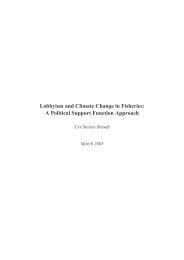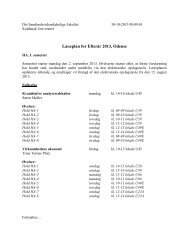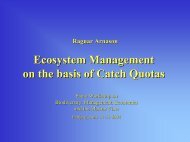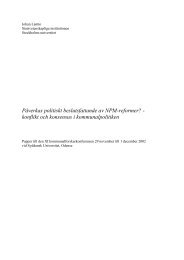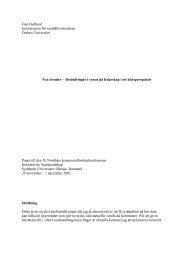A Model of Regulated Open Access Resource Use
A Model of Regulated Open Access Resource Use
A Model of Regulated Open Access Resource Use
You also want an ePaper? Increase the reach of your titles
YUMPU automatically turns print PDFs into web optimized ePapers that Google loves.
REGULATED OPEN ACCESS RESOURCE USE 19<br />
Ž .<br />
qET<br />
A2 approaches zero at some season length defined by PqX0<br />
e 0.<br />
Solving this simultaneously with the rent equation Ž A1.<br />
set equal to zero for T<br />
defines what we refer to as T and we have:<br />
max<br />
PROPOSITION 2. The longest season length that the industry would oluntarily<br />
operate oer is defined by<br />
f ln Ž PqX0.<br />
<br />
Tmax<br />
. Ž A7.<br />
PqX 1 ln Ž PqX . <br />
Ž .<br />
0 0<br />
At season lengths longer than T max, the industry would actually be incurring<br />
negative variable pr<strong>of</strong>its. This can be seen by noting that X0<br />
e qET is equal to the<br />
terminal stock level X . Moreover, since the harvest rate is h qEXŽ.<br />
T<br />
t , PqXT<br />
<br />
is the average daily variable pr<strong>of</strong>it associated with the last unit <strong>of</strong> capacity utilized<br />
on the last day <strong>of</strong> the season. As the season progresses, average variable pr<strong>of</strong>its per<br />
day decline from their initial maximum <strong>of</strong> <strong>of</strong> PqX to their minimum <strong>of</strong><br />
0<br />
PqXT<br />
on the last day. Thus Proposition 2 ensures nonnegative variable pr<strong>of</strong>its<br />
throughout the season. Season lengths larger than T would be forcing the<br />
industry to fish the ending biomass down to levels that generate variable pr<strong>of</strong>it<br />
losses at season end and the industry would always choose not to incur such losses<br />
by truncating fishing at T max. Hence season lengths where regulations are binding<br />
are limited to those between Tmin<br />
and T max.<br />
If T T T , then the numerator <strong>of</strong> Ž A2.<br />
will be negative and the sign <strong>of</strong><br />
min<br />
max<br />
the derivative will be positive. The second derivative <strong>of</strong> the entry function with<br />
respect to T can be shown to be<br />
<br />
<br />
<br />
2 qET 2<br />
2 2 qET<br />
0 0<br />
dE PqX e f Pq EX e<br />
E 2 . Ž A8<br />
2 qET<br />
3<br />
.<br />
dT T Ž PqX e . f<br />
qET<br />
0 T PqX e f<br />
max<br />
Ž 0 .<br />
Ž<br />
qET<br />
At T , the PqX e .<br />
max 0<br />
terms vanish and hence the second derivative is<br />
negative. Hence, over the relevant range, as T increases E also increases monotonically,<br />
reaching a maximum at ET Ž . as shown in Fig. 1.<br />
max<br />
<br />
<br />
<br />
APPENDIX B<br />
Comparatie Statics and Existence <strong>of</strong> a <strong>Regulated</strong> Equilibrium<br />
Comparative statics properties <strong>of</strong> the regulated open access model are tedious<br />
but easily derived. The basic model is as denoted in the text in equation system Ž 12.<br />
along with the quota rule Ž. 5 and the biomass dynamics equation Ž. 8 with the<br />
biological equation assumed to be in a steady state. As discussed above, the system<br />
is recursive and the parameters a, b, c, and d determine equilibrium values for the<br />
biomass level X and the quota Q. Comparative statics properties <strong>of</strong> the equilibrium<br />
levels <strong>of</strong> E and T in the industryregulator block can be computed most<br />
simply by determining the direct effects <strong>of</strong> parameters and the indirect effects <strong>of</strong><br />
parameters operating on the biomassquota block. ŽComparative statics calculations<br />
are available upon request from the authors..


